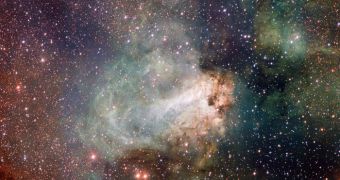The European Southern Observatory (ESO) is proud to announce the inauguration of the latest addition to its Chile-based Paranal Observatory. The Very Large Telescope (VLT) Survey Telescope (VST) is one of the most advanced astronomical units ever created.
Just a few days ago, the new instrument released its first images, which focused on renowned cosmic structures, such as the Omega Nebula and the globular cluster Omega Centauri. The new images of the southern sky impressed everyone.
Mounted on the VST is a huge, 268-megapixel camera called OmegaCAM, which completes the state-of-the-art, 2.6-meter telescope perfectly. Together, the two instruments are capable of producing very fine image quality, while at the same time browsing quickly across the night sky.
The new telescope functions in visible-light wavelengths. The reason why this design was installed at the Cerro Paranal facility is that the Visible and Infrared Survey Telescope for Astronomy (VISTA) instrument already operated by ESO there conducts mostly infrared surveys.
Working together, VISTA and VST could cover a larger portion of the electromagnetic spectrum, from infrared to visible-light, stopping at the borders of ultraviolet wavelengths.
VST “is housed in an enclosure immediately adjacent to the four VLT Unit Telescopes on the summit of Cerro Paranal under the pristine skies of one of the best observing sites on Earth,” ESO experts say.
“The VST is a wide-field survey telescope with a field of view twice as broad as the full Moon. It is the largest telescope in the world designed to exclusively survey the sky in visible light,” the organization adds in a press release.
Experts at the Observatory say that the data VST and OmegaCAM will collect over the next few years will be assembled into some of the clearest, most in-depth surveys of the southern skies ever created. The end products will be made public.
“I am very pleased to see the impressive first images from the VST and OmegaCAM,” explains the director general of ESO, Tim de Zeeuw.
“The unique combination of the VST and the VISTA infrared survey telescope will allow many interesting objects to be identified for more detailed follow-up observations with the powerful telescopes of the VLT,” he goes on to say.
“The VST project has overcome many difficulties but it is now repaying, with its excellent image quality, the expectations of the astronomical community and the efforts of the many people at INAF involved in its construction,” Tommaso Maccacaro says.
“I am very pleased to see the VST in operation,” adds the official, who is the president of the Italian National Institute for Astrophysics (INAF).

 14 DAY TRIAL //
14 DAY TRIAL //